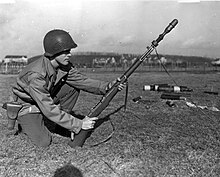| M9 | |
|---|---|
 An M9 grenade on an M7 grenade launching adapter | |
| Type | Rifle Grenade |
| Place of origin | United States |
| Service history | |
| Used by | United States Australia Canada India Pakistan United Kingdom China North Vietnam |
| Production history | |
| Produced | January 1942–July 1945 |
| No. built | ~26,876,000 |
| Variants | M9A1, Type 64 |
| Specifications | |
| Mass | 590 g (21 oz)[1] |
| Length | 284 mm (11.2 in) |
| Diameter | 48 mm (1.9 in) |
| Filling | Pentolite |
| Filling weight | 113 g (4.0 oz) |

The M9 rifle grenade was an American anti-tank rifle grenade used during World War II. The earlier-designed M10 grenade was too heavy to be fired an effective distance by a rifle; the M9 was conceived as a lighter version of that design. (The M10 became part of the evolution of the bazooka.)
Towards the end of the Second World War, the M9's limited effect against heavy German tanks began to be noticed. Its ineffectiveness on heavy armor became apparent when US forces engaged T-34 tanks in the Korean War. It was replaced in the anti-tank role by the M28, an American version of the Energa rifle grenade, which was itself replaced several years later by the M31 HEAT rifle grenade.
The M9 was adopted by the British as the No. 85 grenade in 1944,[2] and was similarly superseded by the Energa in British service during the 1950s. This new munition in the Commonwealth armoury required adapted discharger cartridges, which were made in the UK, Canada, Australia, India and Pakistan.[2]
China adopted a copy of the M9A1 rifle grenade, as Type 64. It was used by North Vietnamese forces during the Vietnam War, and was fired from AT-44 grenade launchers fitted on M44 Mosin-Nagant carbines.[3]
- ^ Ian V Hogg (20 August 2013). The American Arsenal: The World War II Official Standard Ordnance Catalogue. Frontline Books. p. 329. ISBN 978-1-47389-703-8.
- ^ a b "British Military Small Arms Ammo - rifle grenade discharger cartridges". Retrieved 24 April 2017.
- ^ Rottman, Gordon L. (10 February 2009). North Vietnamese Army Soldier 1958–75. Warrior 135. Osprey Publishing. pp. 28–29. ISBN 9781846033711.